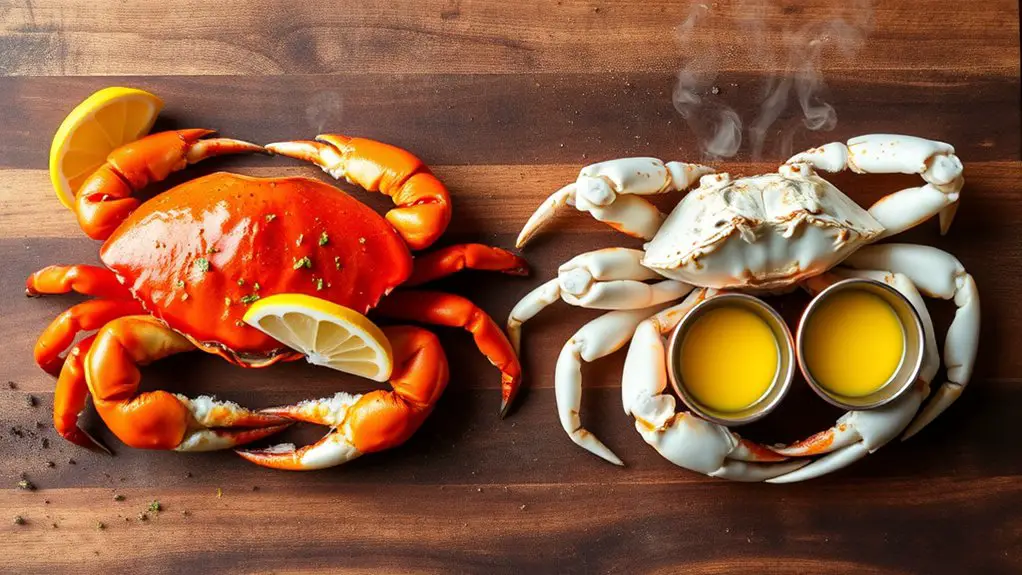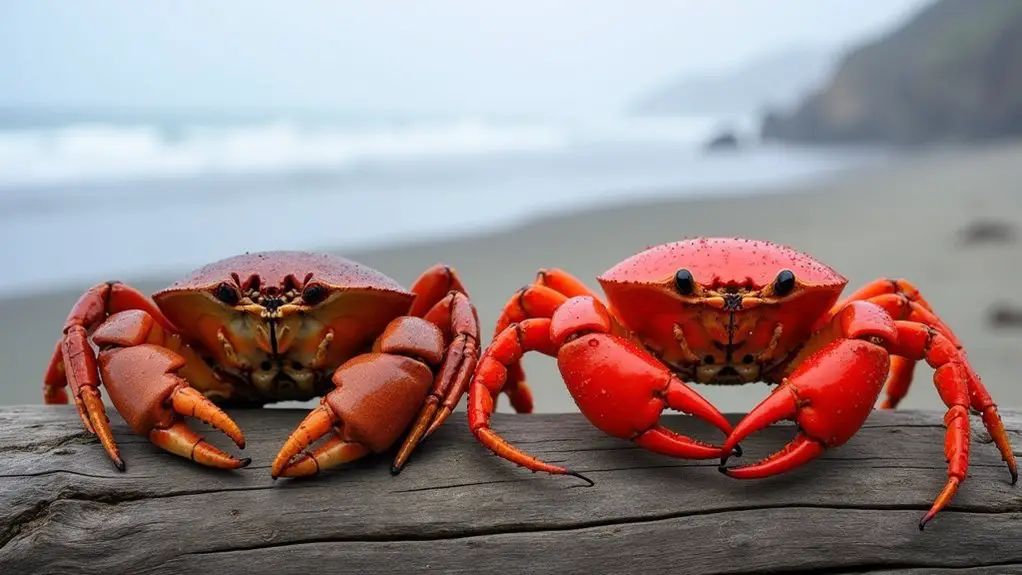Dungeness crabs offer a rich, nutty flavor with firm, flaky meat in their oval, purplish-gray shells found in Pacific coastal waters (38-65°F). Snow crabs, with their milder, sweeter taste and tender meat, inhabit colder North Atlantic and Pacific depths (32-39°F) with distinctive long legs and round shells. You’ll get more meat from snow crabs (25-30% vs. 20-25%), though Dungeness provides superior omega-3s. Both steam beautifully in 4-5 minutes, but their culinary applications might surprise you.
Surf Fishing Highlights
- Dungeness crabs live in warmer Pacific waters (38-65°F) while snow crabs inhabit colder North Pacific and Atlantic waters (32-39°F).
- Dungeness crabs have oval purplish-gray shells while snow crabs feature flatter, rounder shells with longer legs in sandy-brown to red colors.
- Dungeness meat has a rich, nutty flavor and firmer texture, while snow crab offers milder sweetness with more tender, succulent meat.
- Snow crabs have a higher meat-to-shell ratio (25-30%) compared to Dungeness crabs (20-25%) and contain slightly more protein.
- Dungeness crabs command premium prices during their limited season, while snow crabs are more affordable and available year-round.
Habitat and Geographic Range: Where to Find Each Crab Species
While both are prized for their sweet meat, Dungeness and snow crabs couldn’t have chosen more different neighborhoods to call home.
These delectable crustaceans may share culinary fame, but their address preferences couldn’t be more opposite.
You’ll find Dungeness crabs along the Pacific coast from Alaska down to California, preferring warmer waters (38-65°F) in sandy or muddy coastal habitats. They are generally abundant![]() in Whatcom County and surrounding areas.
in Whatcom County and surrounding areas.
Snow crabs, the cold-water cousins, inhabit the chilly depths of both North Pacific and Atlantic Oceans, thriving in near-freezing temperatures (32-39°F).
Though they briefly cross paths in Alaskan waters, they’re rarely roommates—Dungeness enjoys shallow bays and estuaries, while snow crabs venture into the deep, sometimes plunging 2,000 meters below the surface! Dungeness crabs can occasionally be found in deeper waters, with some specimens discovered at depths of up to 800 meters![]() below sea level.
below sea level.
Physical Characteristics: Shell Shape, Color and Leg Structure
Identifying these crustacean cousins becomes a breeze once you understand their distinctive physical features.
Dungeness crabs sport a broad, oval carapace with purplish-gray coloration, while snow crabs showcase a flatter, rounder shell in sandy-brown to bright red hues. You’ll notice snow crabs’ dramatically longer legs compared to the Dungeness’s sturdier, shorter limbs. The distinctive appearances reflect their adaptation to different habitat depths![]() , with Dungeness preferring shallow waters and snow crabs thriving in deeper environments. Dungeness crabs maintain a rusty orange color
, with Dungeness preferring shallow waters and snow crabs thriving in deeper environments. Dungeness crabs maintain a rusty orange color![]() throughout their lives, sometimes exhibiting purple hues as well. Snow crabs undergo a color transformation as they age, changing from red or orange when young to olive or green
throughout their lives, sometimes exhibiting purple hues as well. Snow crabs undergo a color transformation as they age, changing from red or orange when young to olive or green![]() with distinctive spots in adulthood.
with distinctive spots in adulthood.
- Dungeness crabs reach up to 10 inches wide with robust, curved legs and smaller crushing claws.
- Snow crabs feature delicate, elongated limbs with meatier segments and higher meat-to-shell ratios.
- Shell textures differ too—Dungeness has a slightly rougher surface, while snow crabs display a smoother carapace with tiny spines.
Taste and Texture Profiles: Comparing Flavors and Meat Quality
Beyond their distinctive appearances, the true test of these crabs comes down to what matters most—flavor and texture.
While looks may catch the eye, it’s the flavor symphony and textural dance that truly define a crab’s character.
Dungeness delivers a richer, more complex flavor profile with subtle nuttiness that can stand up to bold seasonings, while snow crab offers a cleaner, milder sweetness with gentle briny notes.
You’ll find Dungeness meat is flakier and slightly firmer—perfect for grilling or serving whole.
Snow crab, the more delicate cousin, gives you tender, succulent meat that’s ideal for shredding into dips or salads.
Both are sweet at heart, but they’re like the difference between a robust wine and a crisp champagne—each delicious in its own right.
When comparing yield, Snow Crab offers a medium meat-to-shell ratio![]() of 25-30%, while Dungeness provides slightly less at 20-25%.
of 25-30%, while Dungeness provides slightly less at 20-25%.
Dungeness crab shines when roasted in garlic sauce![]() , which perfectly complements its naturally nutty and sweet flavor profile.
, which perfectly complements its naturally nutty and sweet flavor profile.
Snow Crab’s versatile texture![]() makes it an excellent choice for a wide range of seafood recipes from simple butter dipping to complex pasta dishes.
makes it an excellent choice for a wide range of seafood recipes from simple butter dipping to complex pasta dishes.
Culinary Applications: Best Cooking Methods and Recipe Ideas

Once you’ve selected your crab variety, mastering the cooking method becomes essential for revealing its full potential.
Steaming both Dungeness and snow crab preserves their natural sweetness, requiring just 4-5 minutes for fresh clusters (double for frozen). The delicate snow crab shines in lighter preparations, while meatier Dungeness stands up to heartier dishes.
- Infuse steaming water with garlic, shallots, and lemon to subtly enhance without overpowering
- Position clusters shell-side down when steaming to keep precious juices locked in
- Try broiling for 2-4 minutes with garlic butter for a delicious caramelized finish
Alternatively, oven baking at 375°F![]() offers even heating, with Dungeness or snow crab reaching perfect warmth in 6-10 minutes when arranged in a single layer. Boiling in seasoned stock
offers even heating, with Dungeness or snow crab reaching perfect warmth in 6-10 minutes when arranged in a single layer. Boiling in seasoned stock![]() can infuse the meat with deeper flavors while minimizing the risk of overcooking. Using crab crackers
can infuse the meat with deeper flavors while minimizing the risk of overcooking. Using crab crackers![]() will make it much easier to break through the shells, especially for the thicker Dungeness and King crab varieties.
will make it much easier to break through the shells, especially for the thicker Dungeness and King crab varieties.
Nutritional Benefits and Market Value Comparison
When you’re weighing your crab options at the seafood counter, nutritional value and price often tip the scales in your decision-making process.
Both varieties deliver impressive protein content, with snow crab edging out slightly higher than Dungeness’s 20g per 3-ounce serving.
Protein-packed powerhouses compete on your plate, with snow crab narrowly winning the muscle-building marathon against Dungeness.
If heart health is your priority, Dungeness crab might be your catch of the day with its superior omega-3 profile (0.269g per serving).
You’ll find snow crab more wallet-friendly and available year-round, while Dungeness commands premium prices during its December-to-August season.
Either choice supports weight management goals—they’re both low-calorie protein powerhouses that won’t weigh down your diet! For cholesterol-conscious consumers, Dungeness crab offers a healthier option with lower cholesterol levels![]() compared to other varieties like Blue Crab. Both crabs provide essential nutrients
compared to other varieties like Blue Crab. Both crabs provide essential nutrients![]() that support brain function and cognitive health when included regularly in your seafood rotation.
that support brain function and cognitive health when included regularly in your seafood rotation.
Sustainability Practices and Seasonal Availability
Choosing between Dungeness and snow crab isn’t just about taste and price—it’s also about making responsible seafood choices for our oceans.
Dungeness fisheries earn top marks for sustainability with their strict regulations and minimal environmental impact.
- Dungeness crabs are available fresh nearly year-round (December-August), while snow crabs have shorter, more variable seasons.
- Your Dungeness purchase likely has a smaller carbon footprint due to localized harvesting compared to snow crab’s longer shipping routes.
- Both species use trap methods with escape rings, but Dungeness habitat (sandy bottoms) experiences less disruption than snow crab environments.
Buying Dungeness crab means directly supporting local fishermen![]() who maintain traditional practices along the Pacific Northwest coast.
who maintain traditional practices along the Pacific Northwest coast.
When in doubt, ask your fishmonger about harvest dates and certification—your dinner choice makes waves!
Frequently Asked Questions
Can People With Shellfish Allergies Consume Either Crab Safely?
No, if you have a shellfish allergy, you shouldn’t consume either Dungeness or snow crab.
Both are crustaceans containing tropomyosin, the protein that triggers allergic reactions. These reactions can range from mild (hives, itching) to severe and life-threatening (anaphylaxis).
Since shellfish allergies tend to be lifelong and cross-reactivity between crustaceans is common, it’s simply not worth rolling the dice on your health—even if those crab legs look temptingly delicious!
How Long Do These Crabs Live in Their Natural Habitats?
You’d think creatures who taste so delicious would be granted longer lives!
Dungeness crabs typically live 6-8 years in the wild, though northern populations near Alaska can reach the ripe old age of 13.
They’re the marathon runners compared to their chilly cousins, snow crabs, who generally clock in at 6-10 years.
Both species’ lifespans vary based on water temperature, habitat quality, and whether they’re lucky enough to dodge your dinner plate!
Which Crab Is Easier to Crack and Eat at Home?
You’ll find snow crab notably easier to crack and eat at home. Its thinner, more brittle shells can often be broken by hand, and the meat pulls out in clean, long strings.
Dungeness crab, while deliciously meaty, requires stronger tools (hello, serious crab crackers!) to break through its thicker shell.
Snow crab’s pre-scored clusters and convenient joints make it perfect for fuss-free dining, whereas Dungeness demands more effort but rewards you with substantial, flaky meat chunks.
Do Dungeness and Snow Crabs Migrate During Their Lifecycle?
Did you know snow crabs can trek up to 200 km during migrations? Both species definitely migrate during their lifecycle, but they’re quite different travelers!
Your Dungeness crab performs mostly vertical migrations as larvae (up at night, down during day) and makes modest habitat shifts as adults.
Snow crabs, the marathon runners of the crab world, journey much farther horizontally—up to 20.5 km per month!
While Dungeness prefers local moves, snow crabs pack their tiny suitcases for seasonal deep-water adventures.
Can Either Crab Species Be Kept in Home Aquariums?
You shouldn’t keep either species in home aquariums. Dungeness crabs require specialized setups with cold water (38-65°F), proper salinity (10-32 ppt), and powerful filtration systems—they typically stop eating in captivity.
Snow crabs are even less suitable, as they need deep, frigid environments that are nearly impossible to recreate at home.
Both produce excessive waste and have complex needs that make them poor candidates for hobbyists. Even the most dedicated crab enthusiast would struggle to meet their requirements!
Conclusion
Whether you’re cracking into the sweet, delicate meat of a Dungeness or savoring the briny richness of snow crab legs, you’ve now got the knowledge to navigate the seafood counter with confidence. Picture yourself at a coastal market, choosing the perfect catch for your next feast. Remember, each crab brings its own ocean-kissed story to your plate. Your perfect crab choice depends on your taste preferences, cooking plans, and what’s swimming in season!

